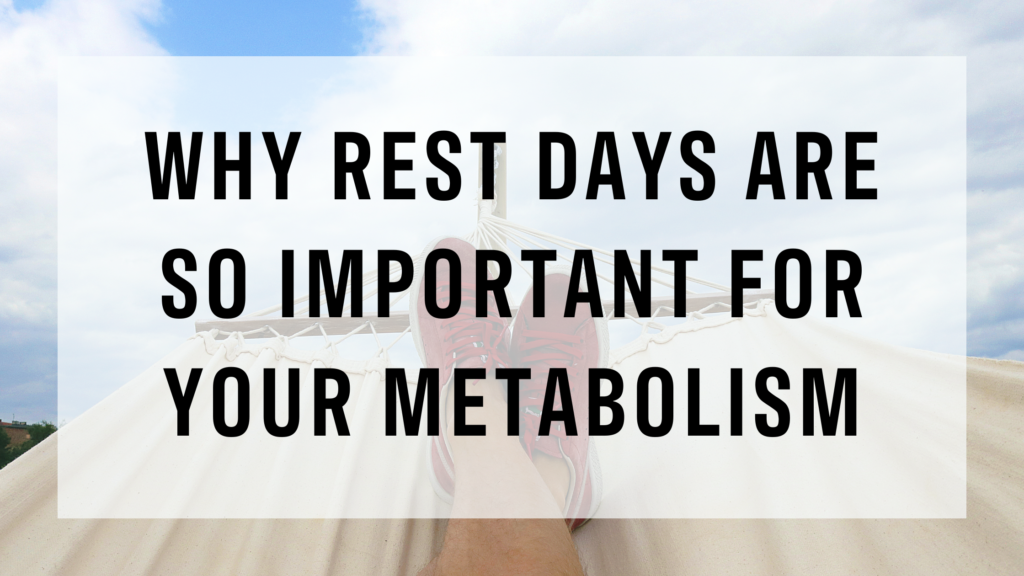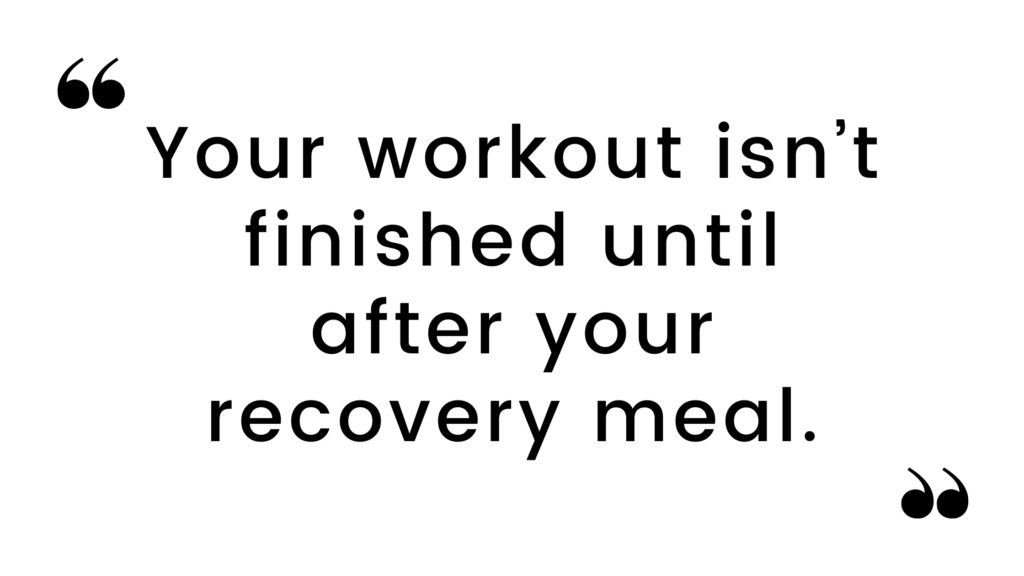
Why Rest Days are so Important for Your Metabolism

Rest days are absolutely in season, on-trend, a must-have. If you don’t include them in your week, what are you even doing?
I know what you’re thinking: “but I want to reach my weight loss goal and that’s not going to happen if I’m sitting on the couch getting emotional over the season finale of ‘This Is Us’”.
Yes. It. Will.
Rest days are CRUCIAL for your weight loss journey, muscle building, and optimal metabolism. Before you can argue with me, I have 3 reasons why this is the case.
#1: they help you avoid over-exercising
I promise you, you don’t need to do strenuous workouts 6-7 days a week. And that’s cardio OR strength training. Doing too much of any form of exercise is very stressful to the body, and we know that this is not supportive of a healthy metabolism.
There is overwhelming evidence to show that “overtraining syndrome” can cause fatigue, sleep loss, weight gain, depression, brain fog, and even decreased performance.
It’s easy to assume that more exercise is always better (because that’s what has been burned into our brains from the beginning), but in reality, it creates an imbalance between our nutrition, activity, and rest needs.
When we put a large demand on our bodies through exercise throughout the week without enough rest, our metabolisms eventually catch on to this “new normal.” It will slow down in order to reserve energy stores, especially when we are not fuelling properly afterward. So even though you’re killing yourself at the gym, your metabolism is essentially going to not care at all and work against you.
In our Metabolism Makeover community of over 5,000 women, there has been a very common theme that increasing rest days and stopping over-exercising habits led to improved metabolism and weight loss efforts across the board.
#2: muscle building
No, that is not a typo. Muscle building is not just about pumping iron. It’s about proper nutrition, progressive overload (slowing and consistently increasing the weight demand to the muscle), and rest days.
To build muscle you must tear the fibers (the workout part), and then you have to let them rebuild. The only way to let them rebuild is to rest.
Research shows that our bodies require longer resting periods (at least 24 hours), specifically for protein synthesis, in order to rebuild muscle tissue. One study explains how our bodies need consistent cycles of exercise and recovery for the muscles to improve and adapt.
What happens if you don’t prioritize rest days? Well, for one, you’re not going to feel great and will have significant muscle soreness. Two, you are not going to see the results from your workouts that you want because your muscles never got the chance to rebuild and grow. Isn’t that the whole point of strength training? To increase muscle mass?
More muscle = better metabolism
#3: you need to replenish
Rest days also allow the body to refill your energy tanks. This is largely in the form of glycogen in the muscles (this is how we store a lot of carbohydrates for energy in the body).
Think about it – exercise of any kind uses carbohydrates as primary fuel, especially if we’re only talking about workouts under 1 hour on average.
Adequate recovery during your week gives the body time to fully replace the glycogen you used from the foods we eat (hint hint: eat your carbs!). What if the body doesn’t get a chance to do this? You are going to be fatigued and sore, and performance will take a hit the next time you work out.
As I mentioned, 24 hours at minimum is required for a proper amount of recovery. This is most critical when we are committing to multiple 30-45 minute intense strength training sessions during the week (and we’re actually lifting HEAVY, ladies). In this case, the muscles are truly being depleted of glycogen stores each time.
We also need to replenish fluids. We don’t need quite as much time to do this, but it definitely needs to be a part of our recovery plan. Don’t be shy with eating enough salt either. This helps our cells actually absorb the fluids we’re drinking and hydrate.

Recovery nutrition
While we’re mostly talking about rest days in this post, prioritizing recovery nutrition during this time is equally as important. It’s like PB&J vibes.
As our MM Coach Eden says: “Your workout isn’t finished until after your recovery meal.”
What should post-workout eating look like? Like any other PHFF meal! Prioritize your protein and starchy carbs especially. If you’re consistent with a strength training routine, up to 50-70g of starchy carbs a day is recommended on workout days to replenish those glycogen stores we talked about.
**This is not total carbohydrate, this is carbs that are specifically from starchy carbs sources like bread, rice, pasta, crackers, fruit, etc.. Your total carbs are going to be over 100 grams, more towards 125-150g total. We go into this in-depth in Metabolism Makeover because we love carbs and your body absolutely needs them.
So, what counts as rest?
If you’re thinking that any exercise that isn’t making you sweat buckets must be equivalent to rest, you’re wrong.
If you want your rest days to count, you need. to. actually. rest.
Now, this doesn’t mean you have to lay in bed all day. You can certainly move your body in ways that feel good while giving it the time off it needs.
This can look like walking, yoga, an *easy* bike ride, stretching, etc.
When it comes to yoga, not all kinds are treated equally. Vinyasa yoga or a session focused on stretching, breathing, and relaxing would count as rest. Yoga sculpt with weights or hot yoga would not count as rest.
Walking is wonderful for rest days – get your steps in! It doesn’t raise your heart rate significantly or tear muscle fibers. A note: walking can also definitely count as exercise on non-rest days too. It’s technically a form of NEAT (non-exercise activity-related thermogenesis). It’s just so great because it’s a non-stressful way to move the body.
How many rest days do I need?
It can look different from week to week depending on how you feel, but a minimum of 2 rest days is what we typically recommend. Remember, though, the goal is to listen to your body, so if you’re feeling like you absolutely need an entire week of rest, then DO IT. Remember, rest days don’t have to mean lazy days!
The cool thing is that your body will always tell you what it needs. Your energy levels, how you’re sleeping, muscle soreness, etc. are all good indicators.
Another hidden sign could be your actual interest in exercising. There are going to be some days when doing the workouts honestly sounds horrible.
Now, take this with a grain of salt, because sometimes it’s in our best interest to move our bodies for so many good reasons, so challenging ourselves to do the workout is a good idea. However, sometimes your brain and your body simply are not going to want to do anything strenuous and that can be a clear sign to take the day off. It feels so much better to exercise when you truly want to!
If you think that if you don’t force yourself to do the workout now you’ll never get yourself to do it later, that is just not true. Our bodies crave movement eventually after proper rest. If you’re finding yourself struggling to keep up with your 6-days-a-week routine, try going down to 4-5 days with more rest and see how that motivation changes. I dare ya.
It’s so easy to cross rest days off the list when we have active weight loss goals, but I challenge you to rethink how you look at them. Rest is required for optimal metabolic health. Rest is productive!
Elle, MM Coach

